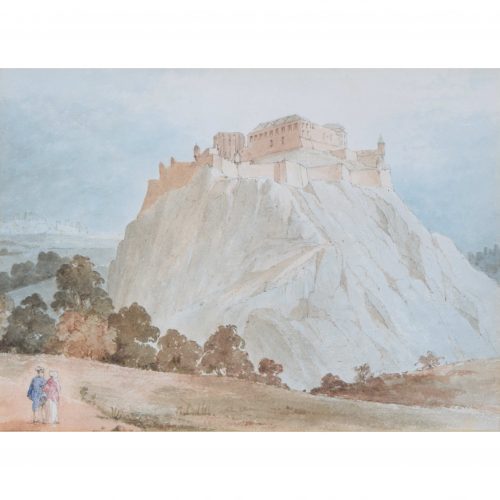-
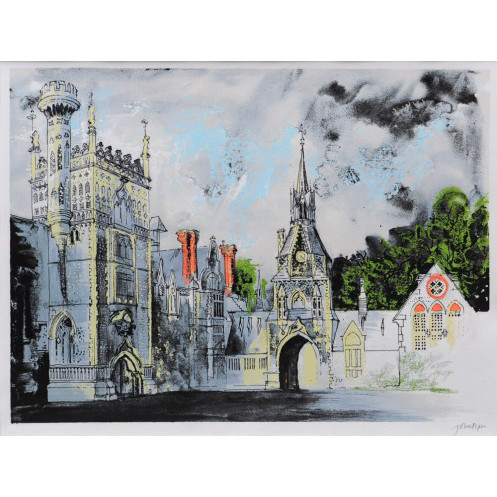
John Piper C.H. (BRITISH, 1903-1992)
Shadwell Park
(Levinson 277) Screenprint in colours, on Arches, signed and numbered. Printed by Kelpra Studio and published by Marlborough Fine Art, London. 510 x 690mm From the 'Victorian Dream Palaces' series of prints by Piper. Click here for biographical details and other works by the artist. If you are interested email info@manningfineart.co.uk or call us on 07929 749056. Condition: generally very good. A little discolouration to extreme margins hidden under mount. In hand-finished black-painted frame. -
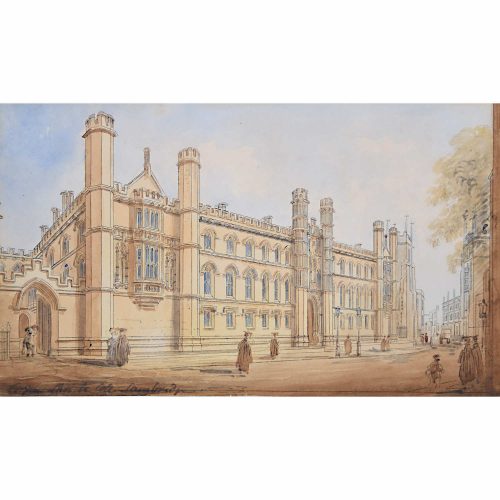
View of Corpus Christi College, Cambridge
Watercolour on paper 13.5 x 23cm A charming view of Corpus Christi College and assorted denizens of Cambridge. The college is notable as the only one founded by Cambridge townspeople; it was established in 1352 by the Guild of Corpus Christi and the Guild of the Blessed Virgin Mary, making it the sixth-oldest college in Cambridge. With around 250 undergraduates and 200 postgraduates, it also has the second smallest student body of the traditional colleges of the University, after Peterhouse. The College has traditionally been one of the more academically successful colleges in the University of Cambridge. It also ranks among the wealthiest Cambridge colleges in terms of fixed assets, being exceptionally rich in silver. Unsigned; labelled 'Corpus Christi Coll. Cambridge' in ink, lower left. If you’d like to know more, please email info@manningfineart.co.uk or call us on 07929 749056. -
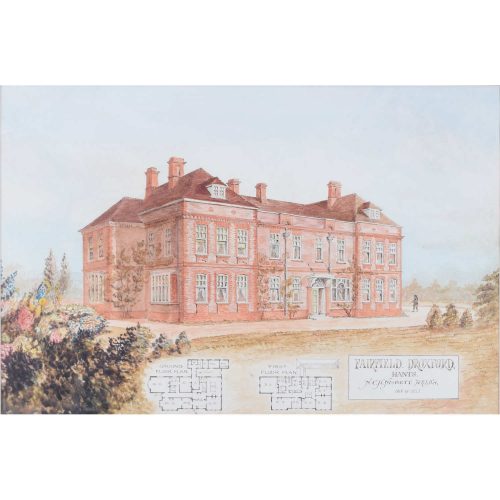
Norman Clayton Hadlow Nisbet ARIBA
Design for Fairfield House, Droxford, Hampshire (c. 1910)
Watercolour and pencil 33 x 51 cm Signed and extensively inscribed. Exhibited at the Royal Academy, 1910. A fine design for an Edwardian country house in England by Norman Nisbet ARIBA, an architect who at the time was practising at 45 Jewry Street, Winchester. The house still stands today, although it is subject to proposals for extension and conversion to a hotel. Condition: very good. -
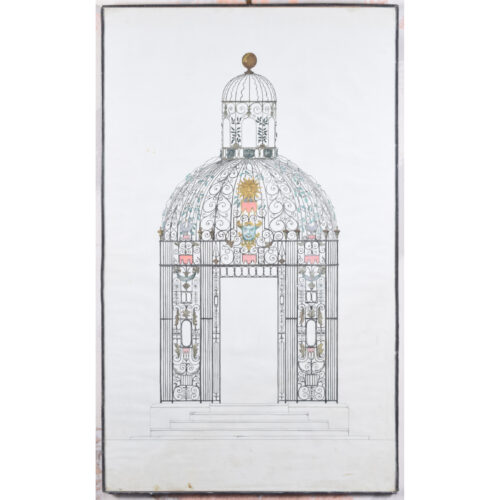
Louis Osman FRIBA (1914 - 1996)
Design for the Restoration of the 'Bird Cage' Arbour, Melbourne Hall, Derbyshire
Mixed media, including pen, ink, watercolour, and gold leaf 108 x 63 cm Provenance: the artist's daughter. In 1958 Osman was commissioned to advise on the restoration of a metal arbour, originally designed in 1708 by Robert Blackwell for the grounds of Melbourne Hall in Derbyshire. The arbour is known as the 'Bird Cage' and was originally painted in a dreamy array of vivid colours; Osman extensively researched Blackwell's work and consulted his original plans for the metalwork in order to restore the arbour to its former glory. The paint was stripped and the iron repainted as per Blackwell's original scheme. The ironwork specialists George Lister & Sons Ltd worked with Osman on the project. This large design features watercolour and gold leaf to illustrate the embellishments Osman had in mind. Osman was as much an artist as an architect. This is likely a portfolio piece from his time studying at the Bartlett School of Architecture, and is as such a piece of architectural history as well as a beautiful Osman design. Osman was awarded a First Class degree and the Donaldson Medal of the RIBA (for the best result in his year group) by the Bartlett, and then went on to the Slade School of Art. He subsequently trained with Sir Albert Richardson - we also have several Richardson works in our collection. After the war, Osman busied himself as an architect. His work included contributions to Westminster Abbey, and Lincoln, Exeter, Ely, and Lichfield Cathedrals, Staunton Harold Church in Ashby de la Zouch for the National Trust, and of course his folly: the Grade I listed Elizabethan manor house, Canons Ashby in Northamptonshire, now a National Trust property. At Canons Ashby he established a workshop and had a team of silversmiths and goldsmiths working for him. In 1976 he made the gold enamelled coffin that holds the copy of the Magna Carta on view in the United States Capitol, Washington, DC. Condition: generally very good; one or two small brown spots to periphery. In artist's original lead-edged frame. If you’d like to know more, please email info@manningfineart.co.uk or call us on 07929 749056. -
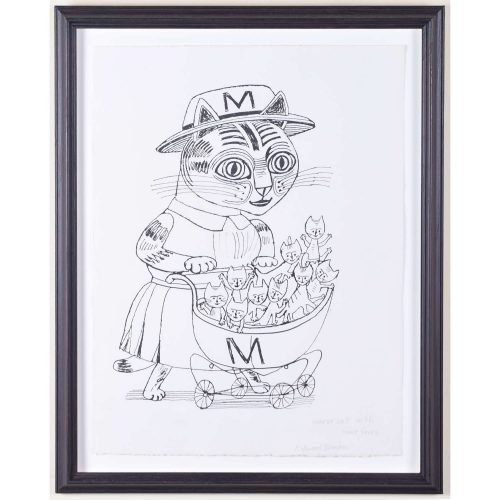
Edward Bawden (1903-1989)
Nurse Cat with Nine Lives
Pen and ink 38 x 27 cm Signed and inscribed lower right. Bawden developed a love of cats at a young age, copying Louis Wain's cat pictures. In his later years, his drawings of cats became yet more frequent; his cat Emma featured in much of his work. In an interview with House and Garden in 1987 he said: "No cat will suffer being lifted up and dropped into an empty space intended for her to occupy; that procedure led inevitably to Emma, tail up, walking away at once, so I had to wait patiently until Emma had enjoyed a good meal of Coley and was ready to choose her daily sleeping place, wherever it might be. I would then spring into action." Doubtless he found it easier to draw an imaginary cat, such as this one. For other cats - and other works - by Bawden, please click here. If you are interested, please email info@manningfineart.co.uk or call us on 07929 749056. -
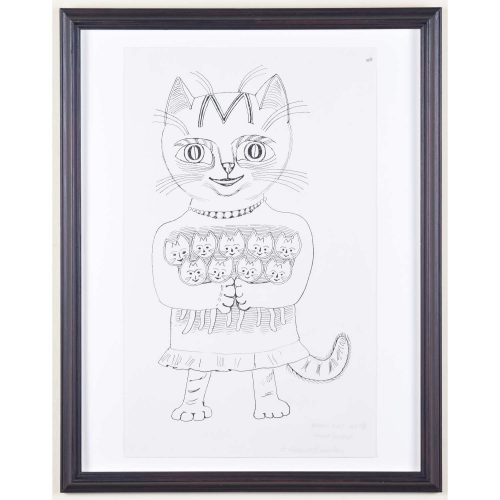
Edward Bawden (1903-1989)
Mum Cat with Nine Lives
Pen and ink 38 x 27 cm Signed and inscribed lower right. Bawden developed a love of cats at a young age, copying Louis Wain's cat pictures. In his later years, his drawings of cats became yet more frequent; his cat Emma featured in much of his work. In an interview with House and Garden in 1987 he said: "No cat will suffer being lifted up and dropped into an empty space intended for her to occupy; that procedure led inevitably to Emma, tail up, walking away at once, so I had to wait patiently until Emma had enjoyed a good meal of Coley and was ready to choose her daily sleeping place, wherever it might be. I would then spring into action." Doubtless he found it easier to draw an imaginary cat, such as this one. For other cats - and other works - by Bawden, please click here. If you are interested, please email info@manningfineart.co.uk or call us on 07929 749056. -
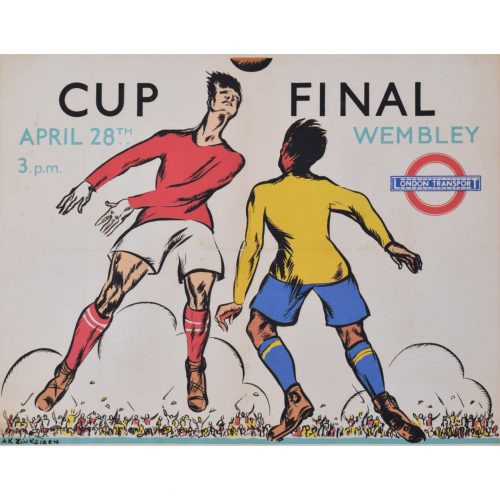
Anna Zinkeisen (1901 - 1976)
Wembley Cup Final (1934)
Lithographic poster 40 x 50 cm Signed in plate lower left, numbered 34/760, and printed by the DPC (Dangerfield Printing Company) for London Transport. Anna Zinkeisen created this design in 1934 for London Transport as a panel poster (12.5 x 10", for display within underground carriages or on buses). The Cup Final that year was between Manchester City and Portsmouth; Manchester City triumphed with a 2-1 scoreline. This particular lithograph from the same time was produced to a slightly larger scale than the panel poster, and is not recorded in the London Transport Museum archives. The process of lithography requires a skilled operator to draw a negative image on a stone plate (the Greek word 'lithos' meaning 'stone') - one plate for each colour in the image. The stone is then treated with acid and etched in a way as to produce a printing plate which can then be inked. Printing at different sizes therefore required the manual creation of new plates, and small differences between different sized versions are thus visible. Anna Zinkeisen won a scholarship to the Royal Academy Schools in 1916, focusing on sculpture and exhibiting at the Royal Academy in 1919. She was awarded the Landseer Award in 1920 and 1921, and went on to become an esteemed portrait artist, often of society ladies. She produced a series of posters for London Transport in the inter-war period. During the Second World War, Zinkeisen became a nurse, and was profoundly affected by the suffering she saw during her time working in St Mary's Hospital. This is arguably the point at which she and her sister Doris reached the pinnacle of their careers, producing some of the finest and most affecting depictions of the world at war made during this period. Condition: good. Backed to conservation paper; small loss to bottom left-hand corner and slight toning to extremities. If you’d like to know more, please email info@manningfineart.co.uk or call us on 07929 749056. -
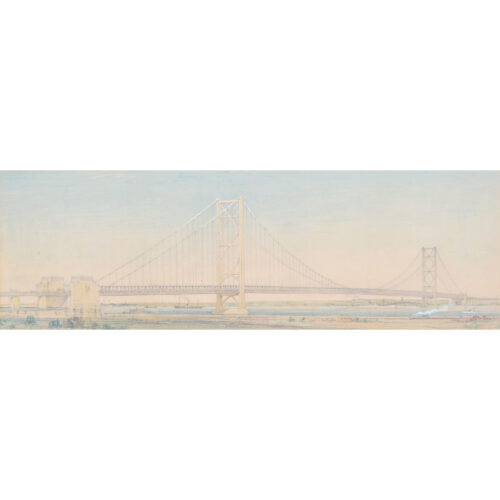
Sir George Gilbert Scott (1811 - 1878)
Preliminary Architectural Design for Forth Road Bridge
Pencil and coloured pencil 24 x 74 cm The architect's design for the Forth Road Bridge, a suspension bridge in Scotland. Gilbert Scott was the consulting architect from the early stages in 1947, but died four years before the bridge was completed. Sir George Gilbert Scott RA was an English Gothic Revival architect, chiefly associated with the design, building and renovation of churches and cathedrals. Condition: generally very good. If you are interested, please email info@manningfineart.co.uk or call us on 07929 749056. Click here for more architectural designs. -
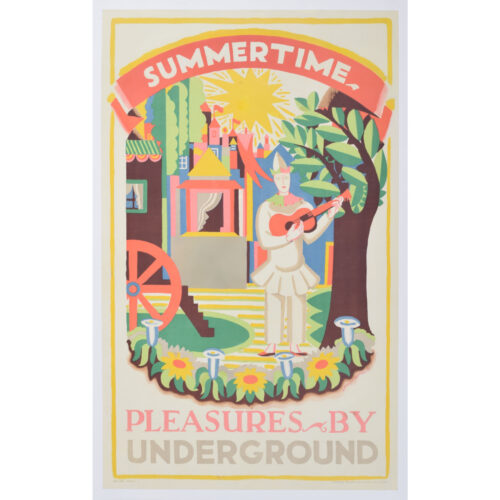
Edward McKnight Kauffer (1890 - 1954)
Summertime - Pleasures by Underground (1925)
Original vintage poster 101 x 63 cm Signed and dated in plate. Issued by the Underground Electric Railways Co. of London, Ltd., 1925. This is one of a series of posters designed by Edward McKnight Kauffer bearing the legend 'Summertime - Pleasures by Underground'. A doleful Pierrot figure (a lovestruck clown character from commedia dell'arte) plays a lute before a castle with streaming pennants; a country caravan, daffodils, leafy trees and a bright yellow sun complete the scene. Other posters from the series include similar traditional folk characters, such as a Jack-in-the-green. Edward McKnight Kauffer was an American artist and graphic designer who lived for much of his life in the United Kingdom. He is mainly known for his work in poster design, but was also active as a painter, book illustrator and theatre designer. He studied art at the California School of Design from 1910 to 1912 and then at the Académie Moderne in Paris until 1914 (via a six month stint at the Art Institute of Chicago). He moved to London upon the start of the First World War and produced 140 poster for London Underground and London Transport. He created posters for Shell Oil, the Great Western Railway and other commercial clients, and also illustrated books and book covers. Later he also became interested in textiles, interior design, and theatrical design. He returned to New York City in 1940 and began designing posters for American Airlines (his primary client until his death) in 1947 .In 1952 he designed the book jacket for Ralph Ellison's novel Invisible Man - arguably Kauffer's most famous work. Condition: generally very good; backed to linen. If you are interested, please email info@manningfineart.co.uk or call us on 07929 749056. Click here for other original vintage London Transport posters. -
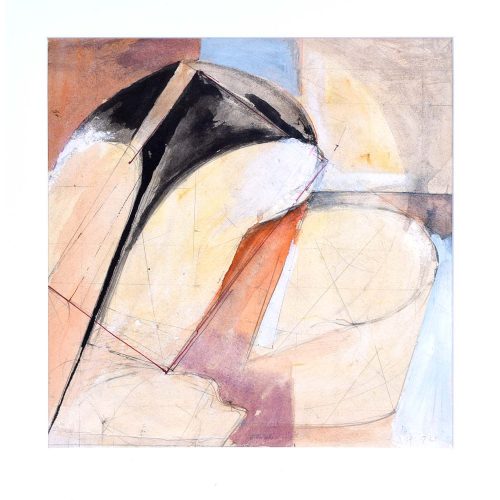
Adrian Heath Abstract Study I (1970)
Gouache & ink 35x33cm Heath was born in Burma in 1920 and arrived in England aged five. In 1938 he studied art under Stanhope Forbes at Newlyn and later at the Slade School of Art. While serving in WWII, he was captured and placed in a prisoner-of-war camp in Bavaria. Heath attempted to escape from the camp but was recaptured and placed in solitary confinement; this isolation proved crucial to the development of his artistic style, as he spent much of his time there experimenting with abstract forms. When released from confinement, Heath befriended a fellow prisoner of war: Terry Frost. Together they explored the methods of painting which they had developed during their time in the camps, and following the war both became celebrated artists. We have several Terry Frost pieces available too. In 1949 and 1951, Heath returned to Cornwall. He spent time with artists like Ben Nicholson, Victor Pasmore, and Anthony Hill, and became the main link between the emerging St Ives School of artists and the British Constructivist movement back in London. He is further credited with promoting British abstract art through informal exhibitions in his studio on Fitzroy Street, as well as his manifesto-like text entitled 'Abstract Art: Its Origins and Meaning', which was published in 1953. Over time, Heath's paintings of abstract geometry and symmetry became increasingly dynamic and heavily textured, the result of layering paint on paint over the course of several days. Here, his colour palette surrenders to the compelling geometry of the painting's abstract forms. If you'd like to know more, please email info@manningfineart.co.uk or call us on 07929 749056. Condition: Good. -
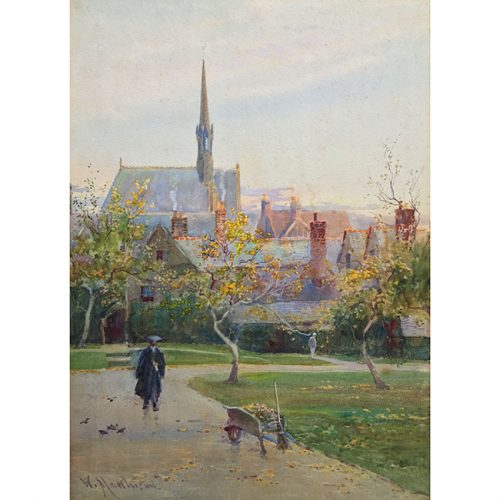
William Matthison (1853-1926)
Trinity Front Quad with Exeter College Chapel, Oxford
Watercolour 36.5 x 26cm Matthison was born near Birmingham and attended King Edward’s School in the city. He learned drawing at the Birmingham Central School of Art and then became a pupil of Birmingham artist Edward Watson. He became a professional artist in 1875 and moved to Oxfordshire a few years after; this was where he had the opportunity to produce many of the Oxford views for which he is known today. In 1902 he moved to Park Town in Oxford and was commissioned by Robert Peel to paint more than seventy views of the University of Oxford, which were subsequently made into postcards. Priced at seven for a shilling, they were only available from E Cross of Pembroke Street (a long-since closed business). Raphael Tuck & Sons also commissioned him to produce postcard scenes of Cambridge. Matthison’s views of Oxford were later printed in Fifty Watercolour Drawings of Oxford, published in 1912 by Alden & Co. Click here for other works by the artist. If you are interested, please email info@manningfineart.co.uk or call us on 07929 749056. -

John Piper (1903-1992)
Capesthorne Hall (1977)
Screenprint 64 x 102 cm Piper captures here, in his usual fanciful colours, the Cheshire stately home of Capesthorne Hall. Built in neoclassical style by William Smith and his son Francis, the hall today is used for weddings and other civil occasions. John Piper CH was an English painter, printmaker, and designer of stained-glass windows. His work often focused on the British landscape, especially churches and monuments, and included tapestry designs, book jackets, screen-prints, photography, fabrics and ceramics. Condition: very good; a little old discolouration to edges under mount. If you are interested, please email info@manningfineart.co.uk or call us on 07929 749056. Click here for other works by John Piper. -
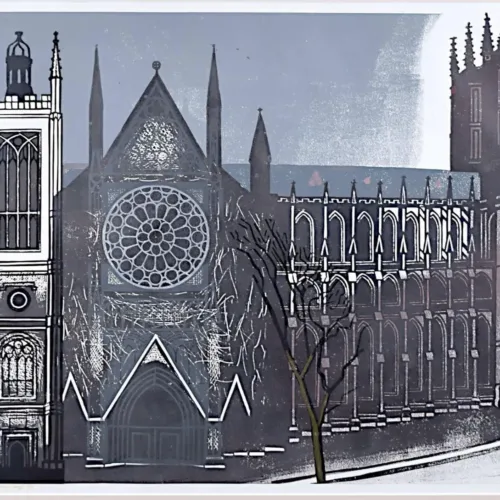
Edward Bawden (1903 - 1989)
Westminster Abbey (1966)
Linocut print 52 x 68 cm (92 x 107 framed) Signed, titled, inscribed 'Artist's Proof' and numbered 42/75 (Bawden inscribed 'Artist's Proof on all of his prints). Bawden's view of Westminster Abbey, cast in shades of blue, grey, and black.Edward Bawden was an English painter, illustrator and graphic artist, known for his prints, book covers, posters, and garden metalwork furniture. Bawden taught at the Royal College of Art, where he had been a student, worked as a commercial artist, and served as a war artist in World War II. He illustrated several books and painted various public murals, and his work and career are often associated with that of his contemporary, Eric Ravilious.Condition: generally very good. Inscription slightly faded. If you are interested, please email info@manningfineart.co.uk or call us on 07929 749056. Click here for other work by the artist. -
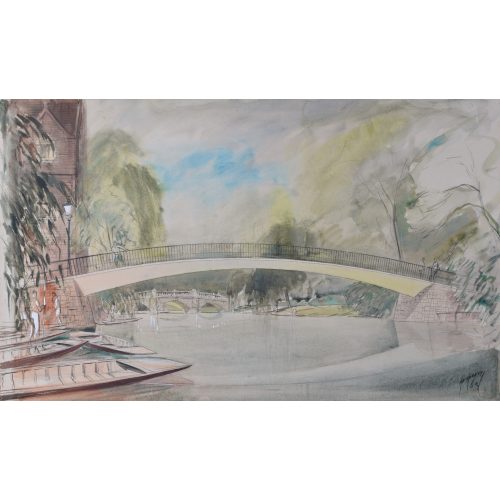
John Dean Monroe Harvey (1895-1978)
Garret Hostel Bridge, Cambridge, Trinity Hall and Clare College behind
38x61cm Watercolour and pencil For biographical details and more works by JDM Harvey, please click here. If you are interested email info@manningfineart.co.uk or call us on 07929 749056. -
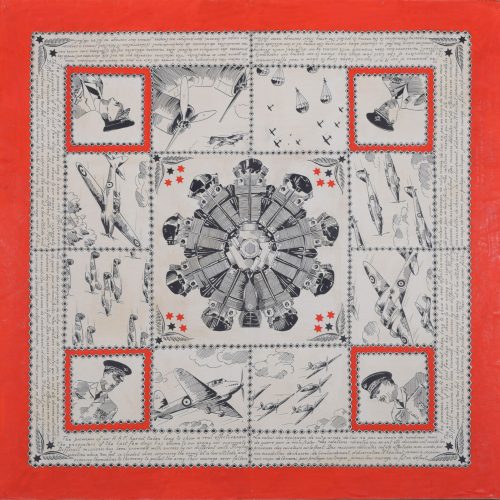
Design for Bianchini Ferier, Lyon for a scarf
Pen and Gouache c. 1940 75cm x 75cm "The prowess of our R.A.F. has not taken long to show a real effectiveness. The encounters of the last few days has sown to our enemy our supremacy. Difficult missions have been crowned with success by our different units. Flying sometime above 7000 feet in clouded skies surprising the enemy at a low altitude and exposing themselves to the enemy to protect the army. Their courage never falters." In the months prior to the Fall of France in May 1940 - before the Battle of Britain began - the RAF was in action in the skies above France and this design for a scarf depicts aeroplanes and pilots of the RAF. -
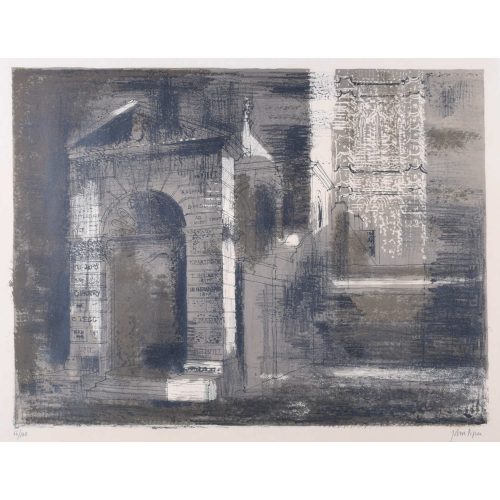
John Piper (1903-1992)
Westminster School I (1961)
49 x 63 cm Signed lower right and numbered 66/100 lower left in pencil. Piper's skilled and characterful rendering of Westminster School's gateway, sometimes known as Burlington's Arch. The historic entrance to the school dates from 1734 and is carved with the names of former pupils. John Piper CH was an English painter, printmaker, and designer of stained-glass windows. His work often focused on the British landscape, especially churches and monuments, and included tapestry designs, book jackets, screen-prints, photography, fabrics and ceramics. Condition: Generally very good, gentle even toning to the paper. If you’d like to know more, please email info@manningfineart.co.uk or call us on 07929 749056. -
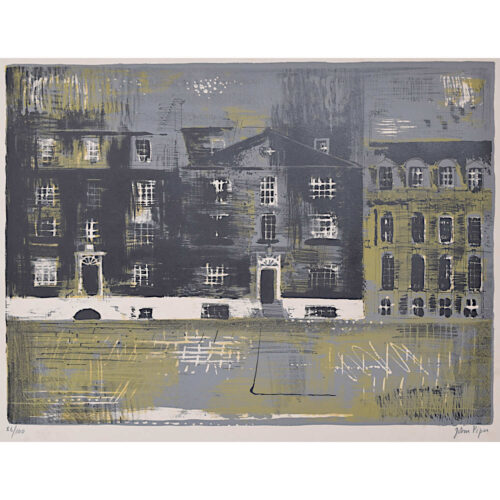
John Piper (1903-1992)
Westminster School II (1961)
42 x 59 cm Signed lower right and numbered 86/100 lower left in pencil. Piper’s second view of Westminster School; both views were commissioned by the school in 1981. Here he depicts Grant's House, with College on the far left and Rigaud’s House on the right. The view is serene and silent, set against a night sky the colour of stone, mimicking the buildings below. John Piper CH was an English painter, printmaker, and designer of stained-glass windows. His work often focused on the British landscape, especially churches and monuments, and included tapestry designs, book jackets, screen-prints, photography, fabrics and ceramics. Condition: generally very good; a little age toning. A few spots to margins. If you’d like to know more, please email info@manningfineart.co.uk or call us on 07929 749056. Click here for other works by John Piper CH. -
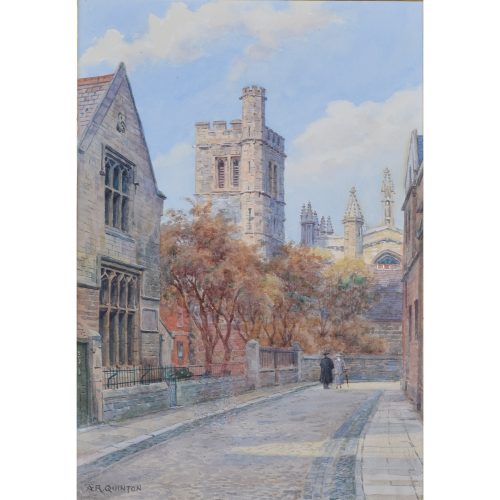
A R Quinton (1853-1934) - Alfred Robert Quinton
New College Bell Tower, Oxford
Signed lower left Watercolour 25x17cm Between 1904 and his death over 2000 of Quinton's paintings were published. Well known for his paintings of landscapes and townscapes of Britain many of his paintings were produced as postcards during the postcard craze of the first decade of the twentieth century; numerous views of Oxford were featured. We have not yet been able to identify a postcard derived from this particular view. If you are interested email info@manningfineart.co.uk or call us on 07929 749056. -
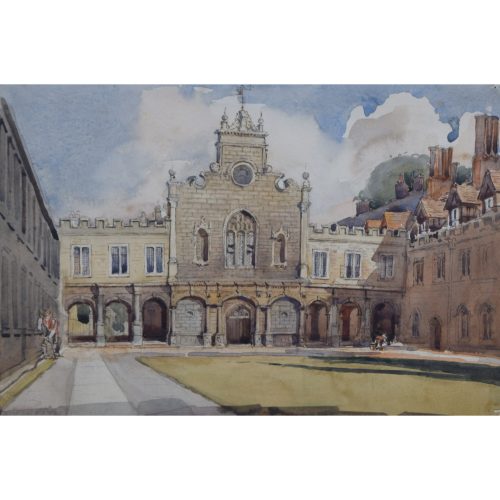
William Thomas Martin Hawksworth (1853-1935)
Peterhouse Cambridge
Watercolour, framed. 17.5 x 26cm. Provenance: with Thomas Agnew & Sons, London A Londoner, Hawksworth was a member of both the RI and RBA. The V&A and British Museum both hold examples of his watercolours. If you are interested email info@manningfineart.co.uk or call us on 07929 749056. -
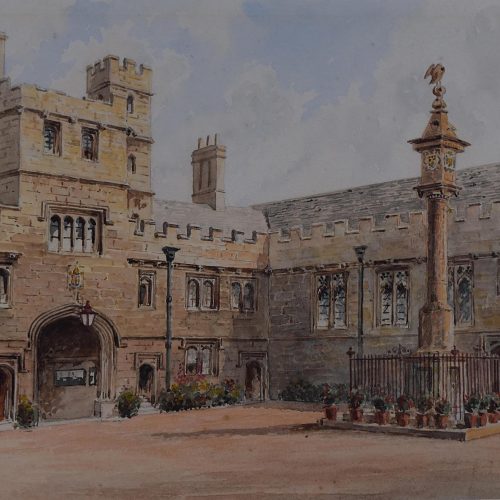
Francis Philip Barraud RA (1834-1901)
Corpus Christi College, Oxford
Watercolour 23 x 33cm Signed lower right. Barraud came from a family of painters. William and Henry were brothers, born in 1810 and 1811 respectively, the former a painter of equine subjects and hounds, the latter a landscape painter, and unusually the two of them made a habit of painting joint commissions. Francis, born in 1824, was a noted topographical artist, being well known for his views of Oxford in particular. Here he handles the old stonework of the College very capably, impressionistic flowers enhancing the scene. If you are interested email info@manningfineart.co.uk or call us on 07929 749056. -
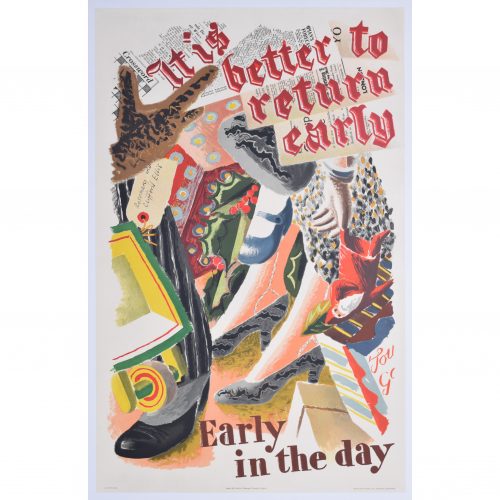
Clifford and Rosemary Ellis
It Is Better To Return Early
Lithographic poster 102 x 61 cm Printed by Waterlow & Sons Ltd for London Transport. This original vintage poster was designed for London Transport and encourages shoppers to head home earlier in the day to avoid congestion on the London Underground and buses. The well-heeled customers in the poster sport smart 1930s shoes, and jostle against their purchases (a Father Christmas puppet and red-berried holly leaves mark the design as published in time for Christmas). The pinstripe-suited gentleman's newspaper serves as the background for the first line of the poster's text, which is slanted in the synthetic cubist style (synthetic cubists were keen to explore collage in their work, often employing collage, especially of newsprint). London Transport was the forerunner of London Underground. During the 1930s London Transport commissioned over forty posters a year from well-known artists such as Laura Knight, CRW Nevinson, Edward Wadsworth, Eric Ravilious, Paul Nash, Graham Sutherland, and Edward McKnight Kauffer – a bold policy that did much to popularise avant-garde artistic styles that stemmed from Cubism, Futurism and Abstraction. Condition: very good, backed to linen. If you are interested, please email info@manningfineart.co.uk or call us on 07929 749056. Click here for other works by Clifford and Rosemary Ellis. -
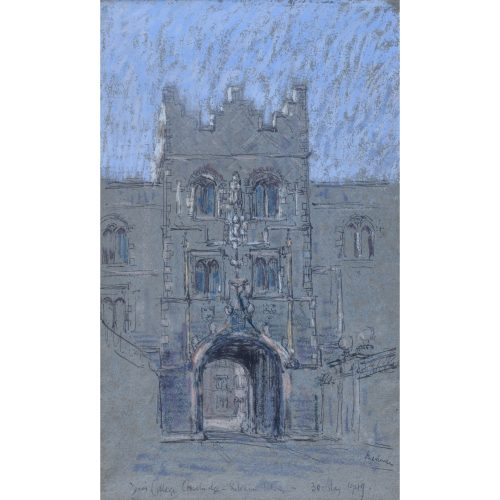
Paul Ayshford Methuen, 4th Baron Methuen of Corsham (1886 -1974)
Jesus College, Cambridge
Ink and pastel Signed and dated 30 May 1949; in artist’s original oak frame. 41x26cm (16.1×10.2 inches) For biographical details and other works by the artist click here. If you are interested email info@manningfineart.co.uk or call us on 07929 749056. -
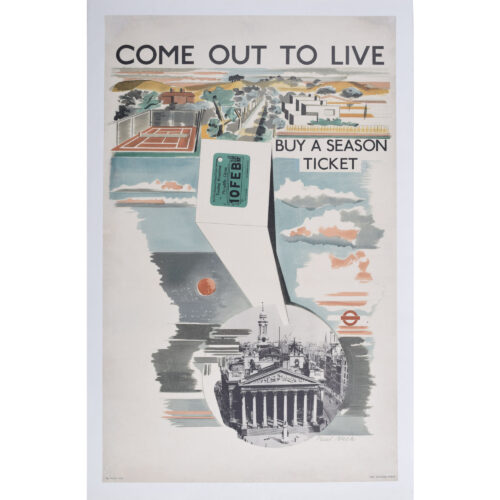
Paul Nash (1889 - 1946)
Come Out to Live (1936)
Original vintage poster 101 x 63 cm A copy of this poster is held by the London Transport Museum. Published by the Baynard Press. Nash's poster encourages us to buy a season ticket in order to travel more cheaply by train. A modernist suburb is juxtaposed with a monochrome photograph of the Royal Exchange in the heart of the City of London, suggesting that by travelling in from suburbia we can "come out to live". Paul Nash was a modernist, surrealist British artist. He is known for his modernist landscapes and work as a war artist. He studied at the Slate School of Art and soon focused his work on landscapes, especially those containing ruins; he went on to produce some of the most recognisable artworks of the First World War, mostly depicting war-torn landscapes. Condition: very good. If you are interested, please email info@manningfineart.co.uk or call us on 07929 749056. Click here for other original vintage posters. -
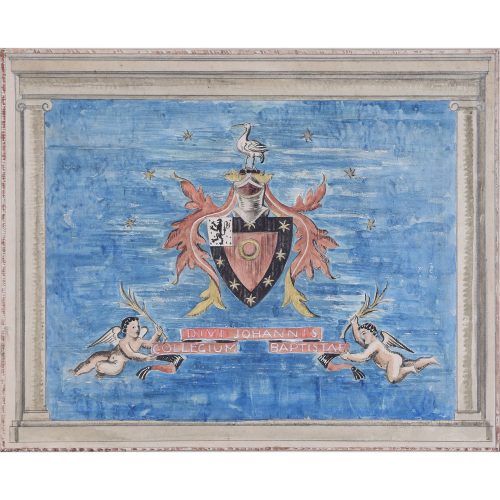
Sir Edward Brantwood Maufe KBE RA FRIBA (1882-1974)
Heraldic Design for a carpet for the Senior Common Room, St John’s College Oxford
Watercolour and ink Signed and inscribed Provenance: The estate of Bernard Bumpus If you are interested email info@manningfineart.co.uk or call us on 07929 749056. 37x46cm (14.5×18.1 inches) Maufe designed buildings for his old Oxford College, St John’s, over an extended period, starting with two memorial slabs in 1923, and was made honorary fellow in 1943. His most major works were the Rawlinson Building extension (1933) and Dolphin Quad (1947). This design relates to the 1936 remodelling of the smoking room of the Senior Common Room. Click here for biographical details and other works by the artist. -
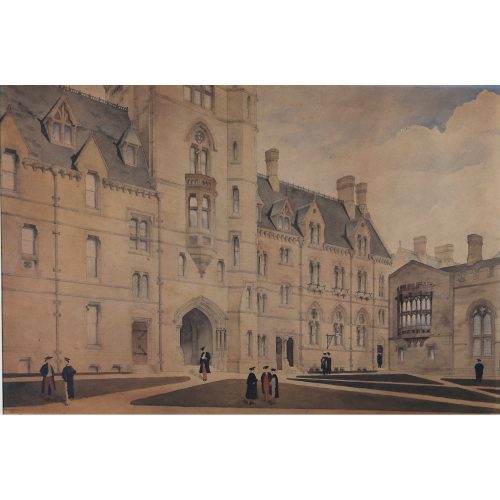 F F Hoyland Balliol College, Oxford (1880) Watercolour 44 x 66 cm Signed lower left and dated. An impressive watercolour of Balliol College. Scholars, sporting gowns and mortarboards, gather in the quad. Hoyland's stylistic precision transforms this watercolour into a beautifully executed depiction of the College's architecture.
F F Hoyland Balliol College, Oxford (1880) Watercolour 44 x 66 cm Signed lower left and dated. An impressive watercolour of Balliol College. Scholars, sporting gowns and mortarboards, gather in the quad. Hoyland's stylistic precision transforms this watercolour into a beautifully executed depiction of the College's architecture. -
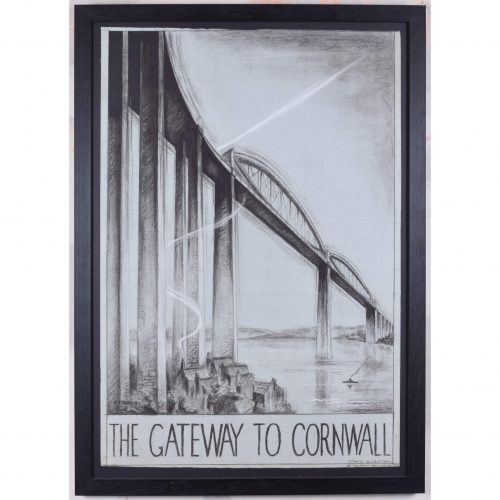
Ronald T Horley (active 1930s - 1940s)
The Gateway to Cornwall
Charcoal heightened with white 76 x 53 cm Signed and inscribed lower right 'Architect's Office, 83 Marlborough Place NW8 Marylebone'. The Great Western Railway commissioned a series of posters promoting train travel around the UK. This charcoal drawing of the Royal Albert Bridge at Saltash is the artist's original design for a poster encouraging rail travel to Devon and Cornwall. The bridge is known fondly as the 'Gateway to Cornwall'. The Royal Albert Bridge was designed by Isambard Kingdom Brunel. Surveying started in 1848 and construction commenced in 1854. The first main span was positioned in 1857 and the completed bridge was opened by Prince Albert on 2 May 1859. Condition: generally very good; a few isolated spots to bottom left corner. Click here for other original vintage travel posters and designs. -
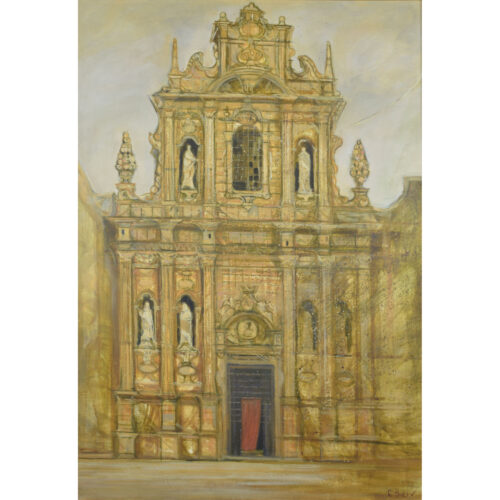
Richard Beer (1928 - 2017)
Lecce Cathedral, Puglia
Oil on canvas 122 x 85 cm Provenance: the artist's studio. A momentous depiction of Lecce Cathedral in all its glory. This oil painting is a fantastic example of Beer's focus on architecture, the central and recurring theme of his pictorial idiom. Born in London in 1928, just too late to serve in the Second World War, Richard Beer studied between 1945 - 1950 at the Slade School. Subsequently, a French Government scholarship allowed him to spend time in Paris at Atelier 17, working under Stanley William Hayter (1901 - 1988), one of the most significant print makers of the 20th Century – having spent the War in New York, advising as a camofleur, Hayter only returned to Paris in 1950. Subsequently Beer studied at the École des Beaux Arts, Paris. Working for John Cranko, choreographer for the Royal Ballet, Beer designed the sets and costumes for his The Lady and the Fool at Covent Garden, subsequently working for him following his move in 1961 to Stuttgart Ballet. Additionally he produced book illustrations and designed book jackets. Beer later taught print-making at the Chelsea School of Art, where he was a popular teacher. Probably his greatest work was a collaboration with John Betjeman to produce a portfolio of prints of ten Wren Churches in the City for Editions Alecto, copies of which are in The Government Art Collection. That collection contains a total of 54 prints by Beer, and the Tate Gallery’s collection holds seven. His Oxford series was also produced for Editions Alecto as was a series of predominantly architectural views in Southern Europe. Most of his prints are of architectural subjects. Condition: generally very good. If you are interested, please email info@manningfineart.co.uk or call us on 07929 749056. Click here for other works by Richard Beer. -
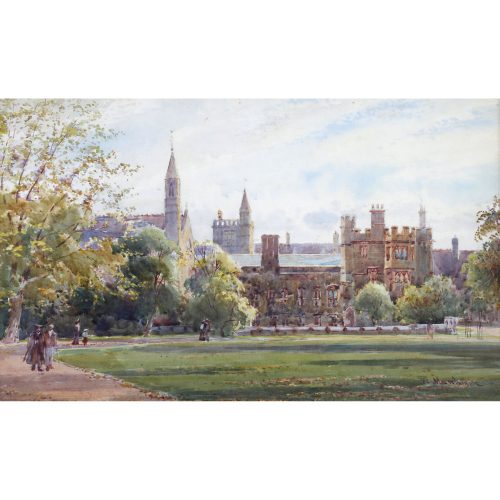
William Matthison
Balliol College Oxford
Watercolour 26 x 44 cm Signed lower right 'W Matthison'. Matthison was born near Birmingham and attended King Edward’s School in the city. He learned drawing at the Birmingham Central School of Art and then became a pupil of Birmingham artist Edward Watson. He became a professional artist in 1875 and moved to Oxfordshire a few years after; this was where he had the opportunity to produce many of the Oxford views for which he is known today. In 1902 he moved to Park Town in Oxford and was commissioned by Robert Peel to paint more than seventy views of the University of Oxford, which were subsequently made into postcards. Priced at seven for a shilling, they were only available from E Cross of Pembroke Street (a long-since closed business). Raphael Tuck & Sons also commissioned him to produce postcard scenes of Cambridge. Matthison’s views of Oxford were later printed in Fifty Watercolour Drawings of Oxford, published in 1912 by Alden & Co. Click here for other works by the artist. If you are interested, please email info@manningfineart.co.uk or call us on 07929 749056. -
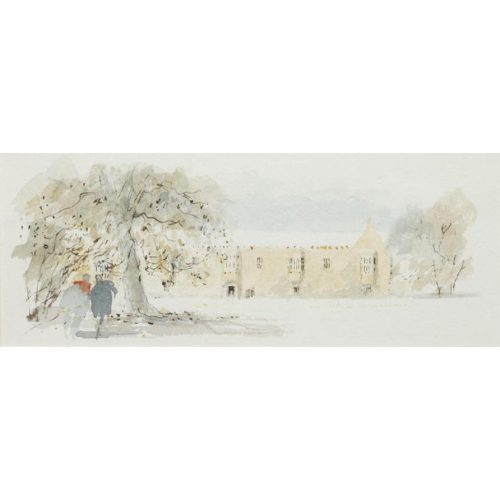 Sir Hugh Casson CH, KCVO, PRA, RDI (1910-1999) St John’s College, Oxford, Canterbury Quad Signed, inscribed with title and dated ‘1988’ (on a label attached to the backboard) Pencil, pen, ink and watercolour 10.5 x 27cm (4 1/8 x 10 5/8in). Painted for inclusion in Hugh Casson’s Oxford (Phaidon Press Ltd, 1988). Click here for biographical details and other works by the artist. If you are interested email info@manningfineart.co.uk or call us on 07929 749056.
Sir Hugh Casson CH, KCVO, PRA, RDI (1910-1999) St John’s College, Oxford, Canterbury Quad Signed, inscribed with title and dated ‘1988’ (on a label attached to the backboard) Pencil, pen, ink and watercolour 10.5 x 27cm (4 1/8 x 10 5/8in). Painted for inclusion in Hugh Casson’s Oxford (Phaidon Press Ltd, 1988). Click here for biographical details and other works by the artist. If you are interested email info@manningfineart.co.uk or call us on 07929 749056. -
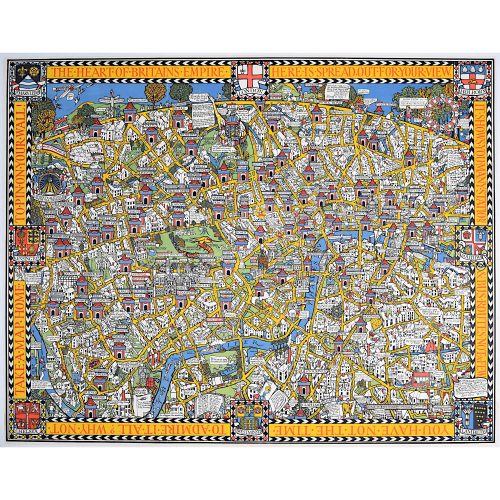
Macdonald (Max) Gill (1884-1947) Wonderground Map of London (c. 1924, after 1914 original edition)
Lithographic poster 75x94cm In the present work, in the top left-hand corner it reads 'On to Wembley' making reference to the British Empire Exhibition of 1924. Gill's original 1914 poster was hugely popular and reprinted with updates to feature topical events. Born in Brighton, Max Gill was the second son in a family of thirteen children; his elder brother was Eric Gill, the typographer and sculptor. Both Gills exhibited significant talent at a young age. Max Gill’s first map was made for a school map-drawing project following which he entered maps into competitions in boys’ magazines. In 1903 he moved to London as assistant to the ecclesiastical architects Sir Charles Nicholson and Hubert Corlette. By 1908 he had started his own architectural practice, but in 1909 Sir Edwin Lutyens commissioned Gill to paint a “wind dial” map for Nashdom, a large house in Buckinghamshire. The wind dial was set over the fireplace and attached to a weather vane on the roof, allowing the occupant to know the direction of the wind from the comfort of the house. He produced seven further wind dials including for Lutyens’s Lindisfarne Castle and for the Allhusen Room at Trinity College, Cambridge. Although he continued to practice as an architect, Frank Pick commissioned him to create seven pictorial maps for the Underground, the first being the famous 1913 ‘Wonderground Map of London Town.’ In 1917 he joined the Imperial War Graves Commission’s headstone design committee, designing the typeface and regimental badges. Gill’s memorials for the fallen in the First World War include for Balliol and Worcester Colleges and Christ Church in Oxford. During the 1920s and 30s Gill undertook many commercial commissions for advertising materials. The Empire Marketing Board and Shell-Mex as well as further maps for the Underground. He designed in 1922 the first diagrammatic map of the Underground which provided the foundation for Beck’s more famous map. By the 1930s his major works were murals. Those of the Arctic and Antarctic on the ceilings of the Scott Polar Research Institute in Cambridge are beautiful, but the most impressive is the map of the North Atlantic in the first-class dining room of the Queen Mary (maiden voyage: 1936, now moored at Long Beach, California). During the Second World War he created a series of propaganda posters for the Ministry of Information. -
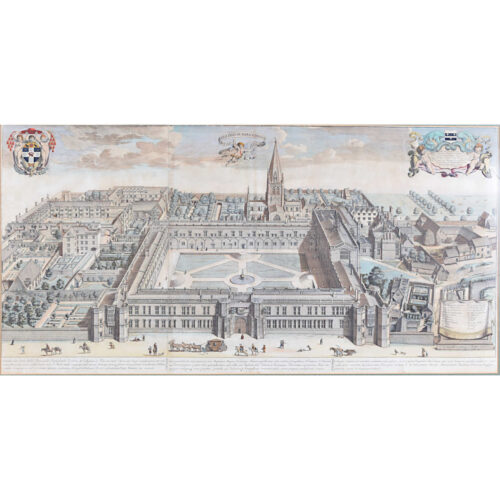
David Loggan (1634-1692)
Christ Church, Oxford (1675)
Engraving 42 x 84 cm Loggan's view of Christ Church from the 'Oxonia Illustrata'. Loggan was born to English and Scottish parents, and was baptised in Danzig in 1634. After studying engraving in Danzig with Willem Hondius (1598-1652 or 1658), he moved to London in the late 1650s, going on to produce the engraved title-page for the folio 1662 Book of Common Prayer. He married in 1663 and moved to Nuffield in Oxfordshire in 1665. Loggan was appointed Public Sculptor to the nearby University of Oxford in the late 1660s, having been commissioned to produce bird’s-eye views of all the Oxford colleges. He lived in Holywell Street as he did this. The 'Oxonia Illustrata' was published in 1675, with the help of Robert White (1645-1704). Following its completion, Loggan began work on his equivalent work for Cambridge; the 'Cantabrigia Illustrata' was finally published in 1690, when he was made engraver to Cambridge University. The 'Oxonia Illustrata' also includes an engraving of Winchester College (Winchester and New College share William of Wykeham as their founder) whilst the 'Cantabrigia Illustrata' includes one of Eton College (which shares its founder, Henry VIII, with King’s College). Bird’s-eye views from this era required a particular talent as an architectural perspectivist; it was not until 1783 that it became possible for artists to ascend via hot air balloons and view the scenes they were depicting from above. Loggan thus had to rely on his imagination in conceiving the views. Loggan’s views constitute the first accurate depictions of the two Universities, in many ways unchanged today. Whilst the Oxford engravings were produced in reasonable numbers and ran to a second edition by Henry Overton (on thicker paper and with a plate number in Roman numerals in the bottom right-hand corner), those of Cambridge were printed in much smaller numbers. The Dutchman Pieter van der Aa published some miniature versions of the engravings for James Beverell’s guidebook to the UK, 'Les Delices de la Grande Bretagne' (circa 1708). The contemporary artist Andrew Ingamells (born 1956) has produced a highly-acclaimed series of etchings which bring Loggan’s original vision up to date. Condition: very good; later hand coloured. If you are interested, please email info@manningfineart.co.uk or call us on 07929 749056. Click here for other views of Christ Church. -
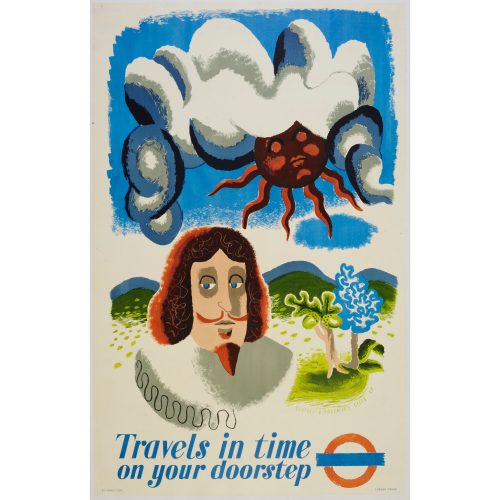
Clifford and Rosemary Ellis
Travels in Time on your Doorstep
Lithographic poster for London Transport (1937) 101 x 63.5 cm Printed by Curwen Press Provenance: the family of the artist, by descent. Condition: A- backed to linen, pin holes to corners. Click here for biographical details and other works by the artist. If you are interested email info@manningfineart.co.uk or call us on 07929 749056. -
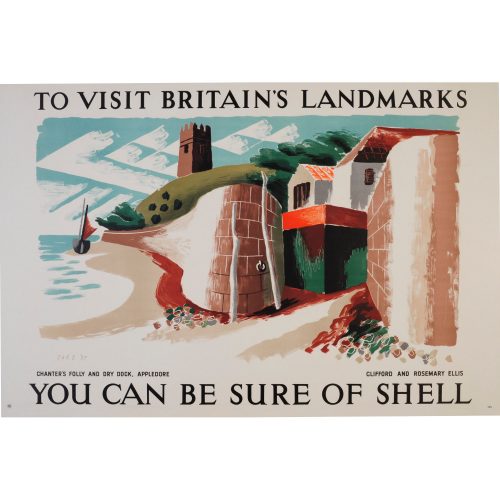
Clifford and Rosemary Ellis
You can be sure of Shell
Chanter's Folly and Dry Dock, Appledore
Lithographic poster for Shell Mex BP (1937) 30x44" Provenance: the family of the artist, by descent. Condition: A/A- backed to linen. Click here for biographical details and other works by the artist. Shell produced a large series of posters in the 1920s and 30s to encourage motorists to use their products in that early and golden age of motoring. They often commission artists not known for their commercial art, so their posters very often featured large and dramatic views of the British countryside and landmarks, inspiring motorists to travel further afield. Here the Ellises have taken a well-known landmark and applied avant-garde artistic techniques so stylising the view, turning, e.g. the clouds into an array of angular v-shaped blocks. Thomas Burnard Chanter (1797-1874) was owner of a fleet of sailing vessels and erected a signal tower ('Chanter's Folly') to give him advance notice of his vessels' arrival. It was demolished in 1952. The dry dock - Richmond dry dock - was built in 1853 and designed to hold two 'large' ships. It exists today and is Grade II listed. If you are interested email info@manningfineart.co.uk or call us on 07929 749056. -
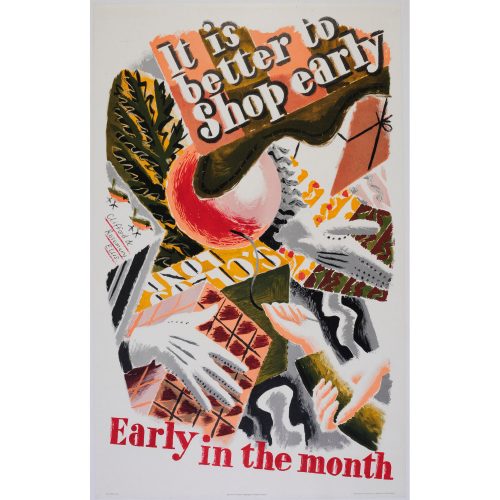
Clifford and Rosemary Ellis
Shop Early (1935)
Lithographic poster for London Transport 101 x 63.5 cm Printed by Waterlow & Sons Ltd For the artist’s biographical details and for other works by the artist available for sale please click here. If you are interested email info@manningfineart.co.uk or call us on 07929 749056. -

Edward Bawden (1903 - 1989)
Aesop's Fables: Peacock and Magpie (1970)
Linocut print 63 x 75 cm Signed, numbered 11/50, and titled in pencil. A delightful print illustrating Aesop's fable of the Peacock and Magpie. In the fable, the birds are searching for a king, and the Peacock puts himself forward. The birds are about to make him king because of his charming plumage, but a Magpie asks the Peacock how he might defend the birds from predators. The Peacock has no answer. Aesop's moral is that those in power must be suited to the task, and not just vain pretenders. The artist's use of vibrant colour brings the tale to life. Edward Bawden was an English painter, illustrator and graphic artist, known for his prints, book covers, posters, and garden metalwork furniture. Bawden taught at the Royal College of Art, where he had been a student, worked as a commercial artist, and served as a war artist in World War II. He illustrated several books and painted various public murals, and his work and career are often associated with that of his contemporary, Eric Ravilious. Condition: generally very good; small stain to extremity that will be hidden under mount. If you’d like to know more, please email info@manningfineart.co.uk or call us on 07929 749056. -
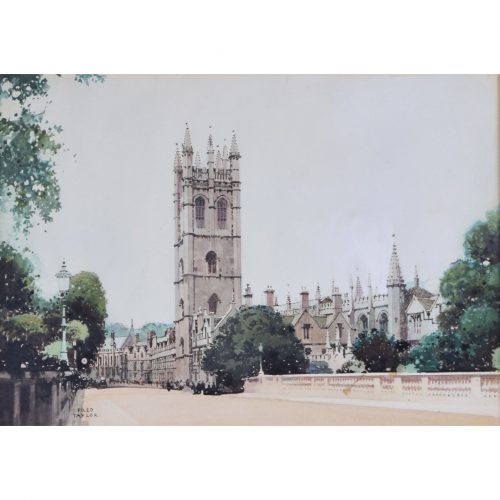
Fred Taylor (1875 - 1963)
Magdalen Tower from Magdalen Bridge
Watercolour 25 x 37 cm Signed lower left. Fred Taylor captures the indomitable features of Magdalen Tower. The spire rises into a pale sky as undergraduates stream past the entrance to the Porter's Lodge. An old-fashioned car drives up the High.This watercolour of Magdalen was a design for the front cover of a guidebook about Oxford.Fred Taylor was a London-born painter and poster designer. He studied at the Académie Julian in Paris, and Goldsmiths’ in London, later travelling to Italy on a scholarship to study art. He produced many poster designs for railway and shipping firms and was an official camoufleur during the Second World War. He exhibited at the Royal Academy.Condition: very good. If you are interested, please email info@manningfineart.co.uk or call us on 07929 749056. Click here for other views of Magdalen College, Oxford. -
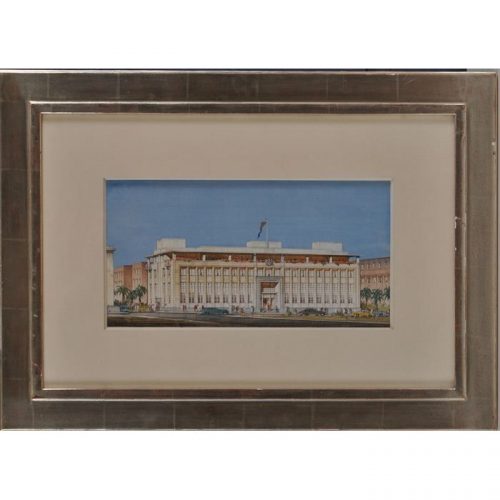
Cyril A. Farey (1888-1954)
National Bank of India, Aden
Watercolour 44x60cm (frame) 17.5×33.5cm (6.8×13.1 inches) Biographical details and other works by Cyril Farey can be found here. In 1839 Aden was taken by the East India Company as a recoaling point between India and the UK. Aden came under the control of the Government of Bombay. In 1937, recognising the geographical distinction between India and Aden it ceased to be a part of British India and became a Crown Colony with its own Governor. If you are interested email info@manningfineart.co.uk or call us on 07929 749056. -
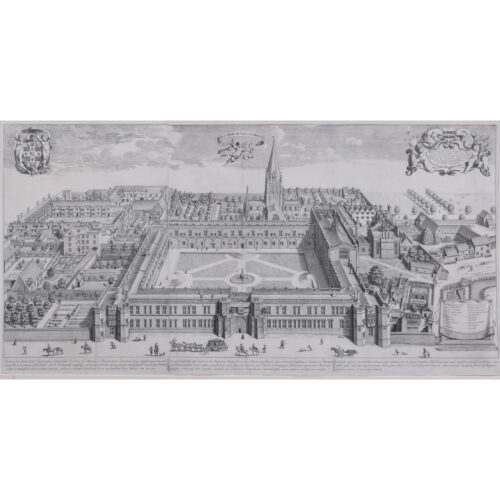
David Loggan (1634 - 1692)
Christ Church, Oxford (1675)
Engraving 42 x 84 cm Loggan's view of Christ Church from the 'Oxonia Illustrata'. Loggan was born to English and Scottish parents, and was baptised in Danzig in 1634. After studying engraving in Danzig with Willem Hondius (1598-1652 or 1658), he moved to London in the late 1650s, going on to produce the engraved title-page for the folio 1662 Book of Common Prayer. He married in 1663 and moved to Nuffield in Oxfordshire in 1665. Loggan was appointed Public Sculptor to the nearby University of Oxford in the late 1660s, having been commissioned to produce bird’s-eye views of all the Oxford colleges. He lived in Holywell Street as he did this. The 'Oxonia Illustrata' was published in 1675, with the help of Robert White (1645-1704). Following its completion, Loggan began work on his equivalent work for Cambridge; the 'Cantabrigia Illustrata' was finally published in 1690, when he was made engraver to Cambridge University. The 'Oxonia Illustrata' also includes an engraving of Winchester College (Winchester and New College share William of Wykeham as their founder) whilst the 'Cantabrigia Illustrata' includes one of Eton College (which shares its founder, Henry VIII, with King’s College). Bird’s-eye views from this era required a particular talent as an architectural perspectivist; it was not until 1783 that it became possible for artists to ascend via hot air balloons and view the scenes they were depicting from above. Loggan thus had to rely on his imagination in conceiving the views. Loggan’s views constitute the first accurate depictions of the two Universities, in many ways unchanged today. Whilst the Oxford engravings were produced in reasonable numbers and ran to a second edition by Henry Overton (on thicker paper and with a plate number in Roman numerals in the bottom right-hand corner), those of Cambridge were printed in much smaller numbers. The Dutchman Pieter van der Aa published some miniature versions of the engravings for James Beverell’s guidebook to the UK, 'Les Delices de la Grande Bretagne' (circa 1708). The contemporary artist Andrew Ingamells (born 1956) has produced a highly-acclaimed series of etchings which bring Loggan’s original vision up to date. Condition: very good. If you are interested, please email info@manningfineart.co.uk or call us on 07929 749056. Click here for other views of Christ Church. -

Bryan de Grineau (1883 - 1957)
The Hall, St John’s College, Oxford
Pencil 34 x 56 cm Signed and titled lower right. Drawing published in The Illustrated London News, 18 June 1955. Condition: very good. Click here for other views of St John’s College by this artist and biographical details. If you are interested, please email info@manningfineart.co.uk or call us on 07929 749056.

